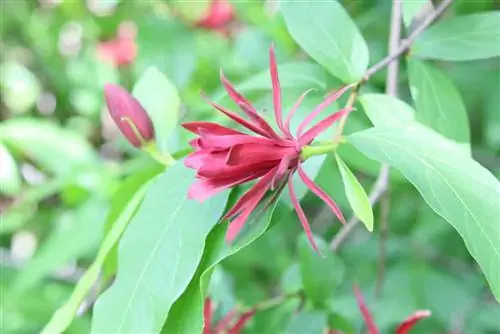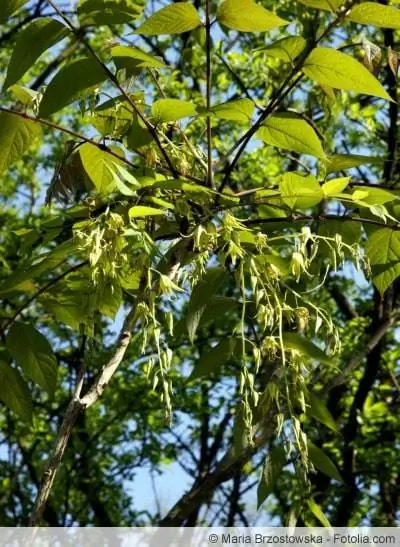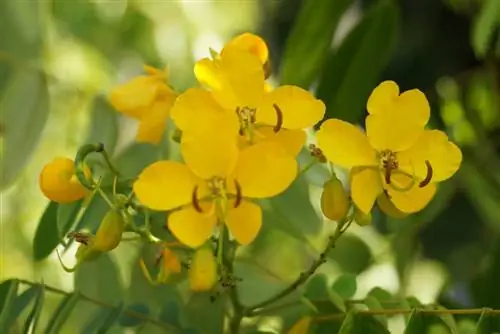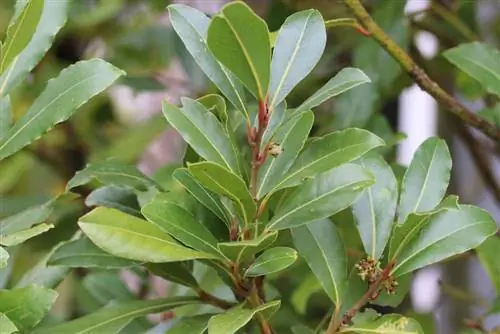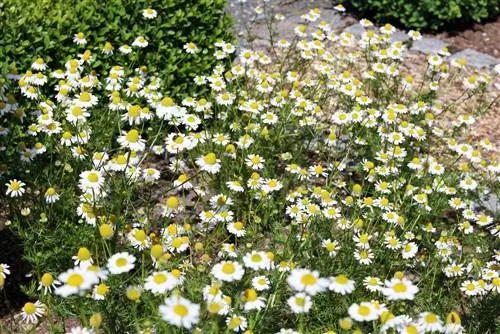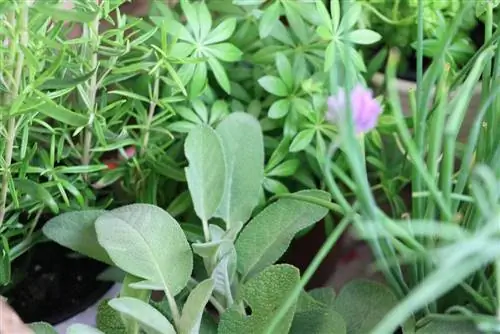- Author admin [email protected].
- Public 2023-12-17 03:39.
- Last modified 2025-01-24 12:45.
The real spice bush is a rarity as it is not often seen in gardens. There are only a few varieties, although the shrub impresses with both its beautiful flowers and its fragrance. The plant looks particularly attractive near terraces. It is very robust against diseases and pests and care is not overly complicated.
Profile: Spice bush
- Latin name: Calycanthus floridus
- Synonym: Clove pepper, spice bush
- Home: Southeastern North America
- Growth: upright, bushy
- Height and width: 3 m high, 2 m wide
- Flowers: red or brown, May to June, scent of strawberries
- Fruits: Capsule fruits
- Leaf color: green, light green
- Special features: fragrant, hardy, slightly poisonous, was used in small quantities by Indians as a spice
Location and soil requirements
In order for it to grow well, the clove pepper needs a suitable location in a protected location. Sun is suitable, but partial shade is also suitable. The shrub does not tolerate midday sun very well. It also grows in the shade, but sufficient sunlight is important for the formation of the flowers and the pleasant scent.
The soil must be moist and nutrient-rich. Soil that is too wet needs good drainage; sandy soil is improved with humus or clay soil so that it can retain moisture better. A slightly acidic soil is well suited, which is why spice bushes like to grow in the company of rhododendrons.
Plants
The clove pepper is usually sold as a pot product. It should be planted soon after purchase, as the pots in stores are often too small. If the shrub stays in the pot for too long, it can die. Planting takes place in spring or early summer. It is important to have enough time until the first frost so that it has grown well.
- A hole is dug at the future location that is slightly deeper than the height of the pot. The substrate is thoroughly loosened. If the soil is compacted, drainage made of gravel can be installed. Lean soil is improved with compost or seasoned manure.
- The shrub is used; it should be planted at the same depth as it was previously in the pot.
- The hole is filled with nutrient-rich soil and the root area is covered with mulch made from grass clippings or pieces of bark. The plant is watered thoroughly.
Fertilize
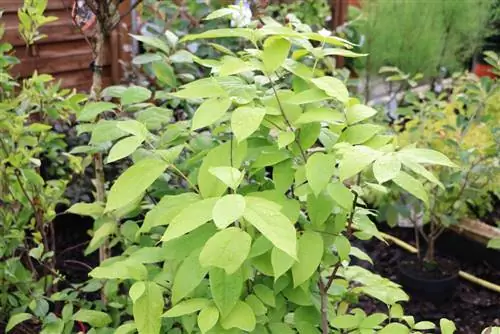
The shrub doesn't need a lot of fertilizer, but while it's still young, adding compost in the spring will help it grow well and bloom beautifully. Shortly before the first frost, you should stop fertilizing so that the shoots become sufficiently woody. Soft shoots could freeze back in winter.
Water
Clove pepper needs a lot of water, especially during the growth phase. It should be watered regularly when it is young. Later it is no longer so sensitive to drought, but it still needs additional water in dry and hot summers. Constant mulching of the root area keeps the soil moist and loose.
Cutting
The shrub does not need to be cut every year, but it tolerates pruning well. It grows on its own in a loose shape. However, as it gets older, rejuvenating pruning can promote flowering. To do this, the three or four oldest branches are cut out close to the ground. The clove pepper is cut during the dormant phase in winter. Then dead wood can also be removed.
Winter hardiness
The clove pepper and its varieties are considered frost-resistant. As long as it is young, however, it is at risk of winter damage. The root area is covered with straw, leaves or brushwood. Frozen shoots can be cut back in spring.
Note:
In very cold winters, a jute bag can be placed over the shoots of very young plants.
Care in the bucket
Under certain circumstances it is possible to keep a spice bush in a container. However, the shrub is not very well suited for this. It is not very heat tolerant and requires a lot of water. The substrate in a bucket dries out more quickly.
- Find a good location. In addition to sun or partial shade, a place where the pot itself remains in the shade and only the bush grows in the sun is particularly suitable. This reduces evaporation and excessive heating of the substrate.
- The container must be significantly larger than the pot in which the clove pepper was purchased.
- The substrate should consist of nutrient-rich soil. Normal potting soil for potted plants can be enhanced with compost.
- The bottom of the bucket is covered with gravel or shards of pottery so that excess water can drain away easily. Then the substrate is filled in and the plant is inserted. The earth is filled and pressed well. Immediately after planting, water thoroughly.
- In the pot, the shrub must be watered regularly and the soil must never dry out completely. Evaporation is also reduced by a layer of mulch. This should always be replaced if it becomes too thin.
- In addition to water, the spice bush in the pot also often needs fertilizer.
- Overwintering in a pot is not as easy as outdoors, even if the plant is generally hardy. Potting soil freezes faster. That's why winter protection can't hurt. The pot is best wrapped in fleece or put away.
Propagation
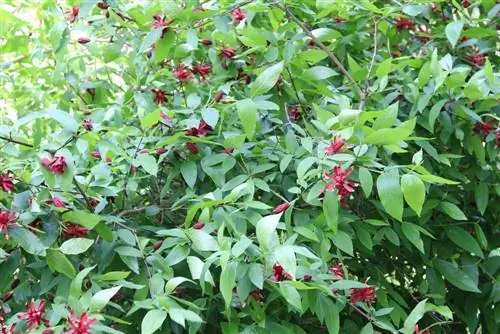
There are various ways to propagate the clove pepper.
Seeds
- suitable for the wild species of Calycanthus
- harvest ripe fruits in October/November
- Shake out seeds
- sow directly outdoors in seed trays
- during the winter, germination inhibition is broken
- the seeds sprout in spring
- separate young plants into pots
- when they are stronger and bigger, they can go outdoors
foothills
- one of the easiest methods to propagate the shrub
- In autumn, root runners are cut off with a spade
- the section is transplanted to the new location
- the shoots are cut back to 10 cm, this promotes branching
- winter protection can be helpful
Cuttings
- more for professionals
- Mother plant should be young and strong
- cut flowerless, unwoody shoots in June
- Growing bed with floor heating and growing soil
- Cut cuttings at the bottom side
- dip in rooting powder and stick into the soil
- it takes a while for the shoots to take root, then they can be separated
Lowers
- suitable for all varieties and hybrids
- long, lateral shoot is buried in the middle in spring
- fix with ground anchor
- roots have formed by autumn
- cut off shoots and transplant next spring
Diseases and pests
The shrub is not very sensitive. No specific diseases are known. Sometimes the shoots, especially the young ones, are attacked by aphids. On the one hand, beneficial insects help against this and, on the other hand, they can be rinsed off with a hard jet of water. If the leaves are wilted, the root area should be checked. It's not just dryness that can be the cause. Waterlogging also shows the same symptoms. The roots begin to rot and can no longer supply the shoots with sufficient water and nutrients. Discolored leaves, especially if they turn brown, can be the result of too much sunlight. Too much sun also causes the edges of the petals to dry out.
Tip:
With a little patience, the clove pepper can also get used to midday sun without any signs of burns.
Varieties

Some attractive hybrids have been created by crossing the Chinese wax or spice bush (Sinocalycanthus chinensis). However, there are hardly any seed-resistant cultivars of the spice bush on the market.
Aphrodite
This shrub remains slightly smaller than the real spice bush. It is 2.50 m wide and just as high. The flowers are wine red, but have a white or cream center. The flowering period is longer than that of the real spice bush and extends from May to September.
Hartlage Wine
This variety grows very sprawling and is more wide than tall. The flower is up to 9 cm in diameter and is light red with a creamy white center. The flowering period is similar to that of the real spice bush.
Venus (Calycanthus venus)
The flowers of this variety are very large at 11 cm. They are white with a reddish center. The Calycanthus venus grows bushy up to 3 m high and is therefore similar to the real spice bush. The flowering time is also the same.

